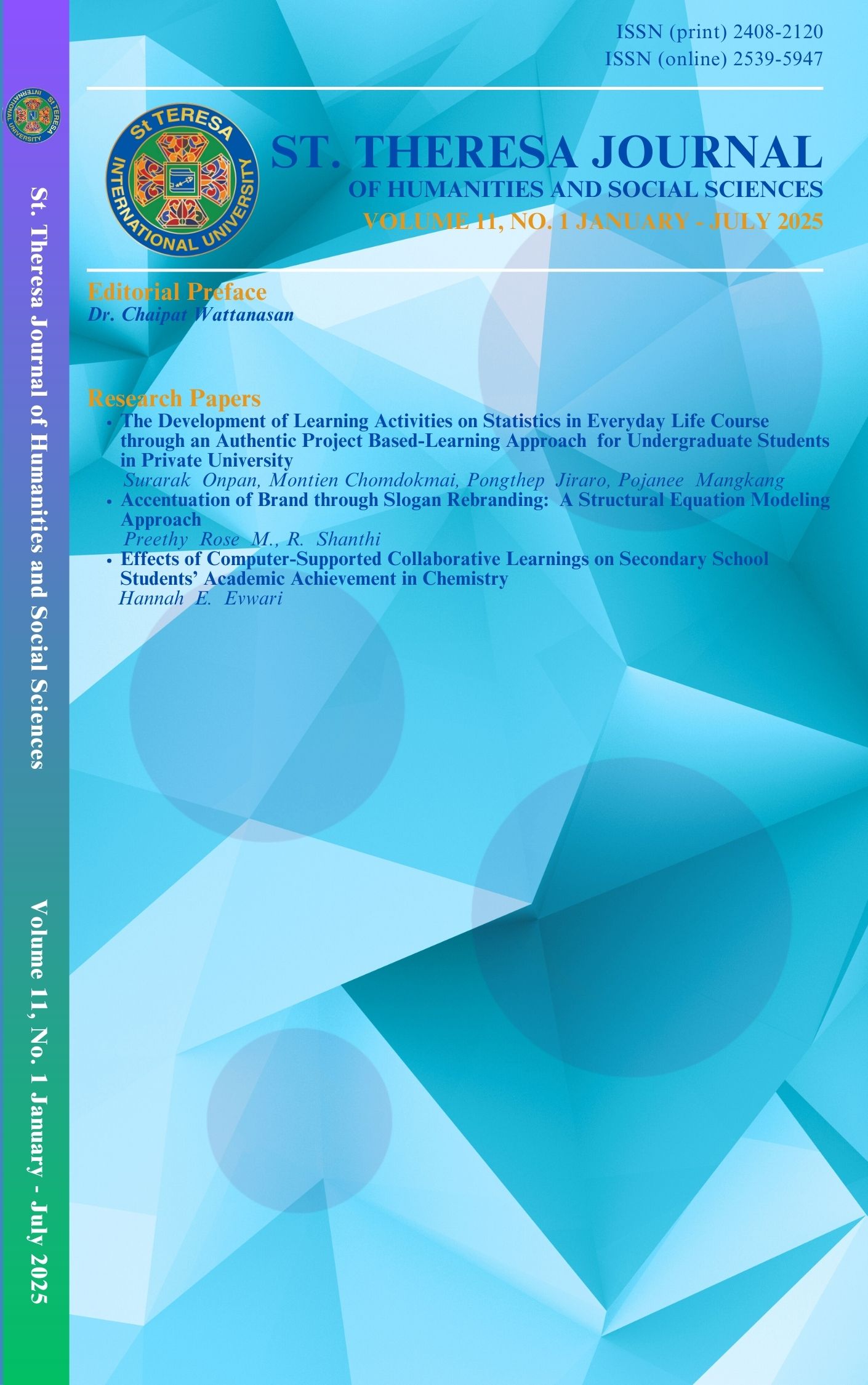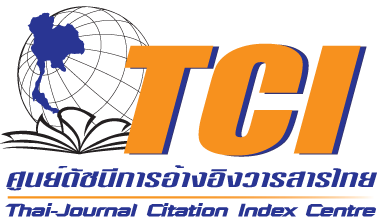The Causal Relationship between Small Entrepreneurial Skills and Innovation Competencies Affecting the Survival of Small Businesses: Empirical Evidence from Thailand
Keywords:
Small Entrepreneurial Skill, Innovation Competencies, Business SurvivalAbstract
This research aims to study the influence of small entrepreneurial skills and innovation competencies on the survival of small businesses. The sample group is 364 small business entrepreneurs. The tools used were questionnaires and statistics used in data analysis including frequency, percentage, confirmatory factor analysis, and structural equation modeling. The research results found that the CFA of all latent variable indicators showed consistency between the research framework and empirical data. In addition, the SEM analysis found that three areas of small entrepreneurial skills, namely digital skills, leadership skills, and management skills, directly influence small business entrepreneurs' innovation competencies, and innovation competencies have a positive direct influence on the survival of small businesses. The finding shows that small entrepreneurial skills lead innovation in small businesses, driving them to expand efficiency, reduce costs, enhance product quality, and improve alignment with consumer demands. By leveraging innovation competencies, small entrepreneurs can anticipate consumer requirements, develop new ideas, and quickly deliver products and services, ultimately ensuring the business's survival and success.
References
Abomaye-Nimenibo, P. D., Samuel, W. A., Umana, E. A., & Usanaga, S. U. (2019). Human Capital Development as a Panacea for Organization Survival of Broadcasting Corporations in Rivers State. International Journal of Latest Research in Humanities and Social Science. 2(5), 1-10.
Acemoglu, D., & Autor, D. (2011). Skills, tasks, and technologies: Implications for employment and earnings: Handbook of labor economics. (pp. 1043-1171).
Adam, N. A., & Alarifi, G. (2021). Innovation practices for the survival of small and medium enterprises (SMEs) in the COVID-19 times: the role of external support. Journal of Innovation and Entrepreneurship, 10(1), 1-22. https://doi.org/10.1186/s13731-021-00156-6
Ahmad, M., Jiang, P., Murshed, M., Shehzad, K., Akram, R., Cui, L., & Khan, Z. (2021). Modeling the dynamic linkages between eco -innovation, urbanization, economic growth, and ecological footprints for G7 countries: does financial globalization matter? Sustainable Cities and Society, 70, 102881. https://doi.org/10.1016/j.scs.2021.102881
Akerman, A., Gaarder, I., & Mogstad, M. (2015). The skill complementarity of broadband internet. The Quarterly Journal of Economics, 130(4), 1781-1824.
Alfrian, F. D., & Riani, R. (2018). The effect of task environment toward the commitment to change: Transformational leadership as a mediator. Russian Journal of Agricultural and Socio-Economic Sciences, 79(7), 85-97.
Alghamdi, F. (2018). Ambidextrous leadership, ambidextrous employee, and the interaction between ambidextrous leadership and employee innovative performance. Journal of Innovation and Entrepreneurship, 7(1), 1-14. https://doi.org/10.1186/s13731-018-0081-8
Ana, A., Hurriyati, R., Rostika, Y., & Nazeri, M. (2016). Entrepreneurial intentions of tourism vocational high school students in Indonesia and Malaysia. Journal of Technical Education and Training, 8(2), 12-20. https://penerbit.uthm.edu.my/ojs/index.php/JTET/article/view/1272/1008
Asghar, N., Khattak, A., Danish, M. H., Bokhari, I. H., & Waris, M. (2023). Managerial skills, technology adaptation and firm performance: Mediating role of process innovation and product innovation. Cogent Business & Management, 10(3), 2281485. https://doi.org/10.1080/23311975.2023.2281485
Baker, S. R., Farrokhnia, R. A., Meyer, S., Pagel, M., & Yannelis, C. (2020). How does household spending respond to an epidemic? Consumption during the 2020 COVID-19 pandemic. The Review of Asset Pricing Studies, 10(4), 834-862. https://doi.org/10.1093/rapstu/raaa009
Boonmalert, W., Ayasanond, C., Phoothong, B., & Chaitorn, T. (2021). A causal influence model of innovation and digital marketing on the small and medium enterprise (SME) performance in Thailand. European Journal of Molecular & Clinical Medicine, 8(3), 63-72. https://ejmcm.com/uploads/paper/503b680d906b6eac6f92fa54a3247fe7.pdf
Brynjolfsson, E., Horton, J. J., Ozimek, A., Rock, D., Sharma, G., & TuYe, H. Y. (2020). COVID-19 and remote work: An early look at US data (No. w27344). National Bureau of Economic Research. https://10.3386/w27344
Cho, E., & Kim, S. (2015). Cronbach’s coefficient alpha: Well-known but poorly understood. Organizational Research Methods, 18(2), 207 230. https://doi.org/10.1177/1094428114555994
Choi, K., & Seltzer, M. (2010). Modeling heterogeneity in relationships between initial status and rates of change: Treating latent variable regression coefficients as random coefficients in a three-level hierarchical model. Journal of Educational and Behavioral Statistics, 35(1), 54-91. https://doi.org/10.3102/1076998609337
Cockburn, I. M., Henderson, R., & Stern, S. (2018). The impact of artificial intelligence on innovation: An exploratory analysis. In The economics of artificial intelligence: An agenda (pp. 115-146). University of Chicago Press.
Drydakis, N. (2022). Improving entrepreneurs’ digital skills and firms’ digital competencies through business apps training: A study of small firms. Sustainability, 14(8), 4417. https://doi.org/10.3390/su14084417
Duncan, R. B. (1976). The ambidextrous organization: Designing dual structures for innovation. The Management of Organization, 1(1), 167-188.
Freze, T., Korneev, A., Krayneva, R., Oruch, T., Kandalov, W., & Strielkowski, W. (2023). Business Leadership and Corporate Social Responsibility in the Post-COVID Era. Economies, 11(3), 98. https://doi.org/10.3390/economies11030098
Hair, J. F., Sarstedt, M., Hopkins, L., & G. Kuppelwieser, V. G. (2014). Partial least squares structural equation modeling (PLS-SEM): An emerging tool in business research. European Business Review, 26(2), 106-121. https://doi.org/10.1108/EBR-10-20130128
Hakim, S., Laelawati, L. N., & Mardiana, R. (2022, December). The Role of Digital Skills and Technological Innovation in Improving the Performance of Small and Medium Industries: Systematic Literature Review. In the International Conference on Global Innovation and Trends in Economics and Business (ICOBIS 2022) (pp. 74-102). Atlantis Press. https://doi.org/10.2991/978-94-6463-068-8_7
Heckman, J. J., & Kautz, T. (2012). Hard evidence on soft skills. Labour Economics, 19(4), 451-464. https://doi.org/10.1016/j.labeco.2012.05.014
Huang, Z., Sindakis, S., Aggarwal, S., & Thomas, L. (2022). The role of leadership in collective creativity and innovation: Examining academic research and development environments. Frontiers in Psychology, 13, 1060412. https://doi.org/10.3389/fpsyg.2022.1060412
Ifekwem, N., & Adedamola, O. (2016). Survival strategies and sustainability of small and medium enterprises in the Oshodi-Isolo local government area of Lagos state. Acta Universitatis Sapientiae, Economics and Business, 4(1), 103-118. https://doi.org/10.1515/auseb 2016-0006
Ismail, I. J. (2022). Entrepreneurs’ competencies and sustainability of small and medium enterprises in Tanzania. A mediating effect of entrepreneurial innovations. Cogent Business & Management, 9(1), 2111036. https://doi.org/10.1080/23311975.2022.2111036
Jaiswal, N. K., & Dhar, R. L. (2016). Fostering employee creativity through transformational leadership: The moderating role of creative self-efficacy. Creativity Research Journal, 28(3), 367-371. https://doi.org/10.1080/10400419.2016.1195631
Janjić, I., & Rađenović, T. (2019). Značaj upravljanja inovacijama u savremenim preduzećima. EKONOMIKA, 65(3), 45-54. https://10.5937/ekonomika1903045J
Jiang, Y., & Chen, C. C. (2018). Integrating knowledge activities for team innovation: Effects of transformational leadership. Journal of Management, 44(5), 1819-1847. https://doi.org/10.1177/0149206316628641
Jovanović, M. N. (2020). Evolutionary spatial economics: Understanding economic geography and location over time. USA: Edward Elgar Publishing.
Kasongo, A., Sithole, M., & Buchana, Y. (2023). Empirical analysis of innovation and productivity in services firms: The case of South Africa. African Journal of Science, Technology, Innovation and Development, 15(1), 1-13. https://doi.org/10.1080/20421338.2021.2001207
Khan, M. N., & Jalees, T. (2017). Human resource management practices and employee performance in Pakistan. Market Forces, 12(2), 60-80.
Khan, S. J., Kaur, P., Jabeen, F., & Dhir, A. (2021). Green process innovation: Where we are and where we are going. Business Strategy and the Environment, 30(7), 3273-3296. https://doi.org/10.1002/bse.2802
Kline, R. B. (2016). Principles and practice of structural equation modeling. New York: The Guilford Press.
Kongnun, T., Rattanapong, S., Yuphuang, C., Puttivisit, P., & Masoot, M. (2022). The Effect of Covid-19 Pandemic on Tourism Travel and Risk Management in Thailand. Journal of Tourism, Hospitality and Environment Management, 7(30), 215-225.
Loo, M. K., Ramachandran, S., & Raja Yusof, R. N. (2023). Unleashing the potential: Enhancing technology adoption and innovation for micro, small and medium-sized enterprises (MSMEs). Cogent Economics & Finance, 11(2), 2267748. https://doi.org/10.1080/23322039.2023.2267748
Malinao, C. W. M., & Ebi, R. G. (2022). Business management competencies as the driver of Small-medium enterprises' survival during the COVID-19 pandemic. Puissant, 3, 296-315.
McClelland, D. C. (1973). Testing for competence rather than for "intelligence". American Psychologist, 28(1), 1-14. https://doi.org/10.1037/h0034092
Mokbel Al Koliby, I. S., Abdullah, H. H., & Mohd Suki, N. (2024). Linking entrepreneurial competencies, innovation and sustainable performance of manufacturing SMEs. Asia-Pacific Journal of Business Administration, 16(1), 21-40. https://doi.org/10.1108/APJBA-09 2021-0480
Murphy, K. R. (2020). Performance evaluation will not die, but it should. Human Resource Management Journal, 30(1), 13-31. https://doi.org/10.1111/1748-8583.12259
Najafi-Tavani, S., Najafi-Tavani, Z., Naudé, P., Oghazi, P., & Zeynaloo, E. (2018). How collaborative innovation networks affect new product performance: Product innovation capability, process innovation capability, and absorptive capacity. Industrial Marketing
Management, 73, 193-205. https://doi.org/10.1016/j.indmarman.2018.02.009
Nicola, M., Alsafi, Z., Sohrabi, C., Kerwan, A., Al-Jabir, A., Iosifidis, C. & Agha, R. (2020). The socio-economic implications of the coronavirus pandemic (COVID-19): A review. International Journal of Surgery, 78, 185-193. https://doi.org/10.1016/j.ijsu.2020.04.018
Nunnally, J. C. (1967). Psychometric Theory. New York: McGraw-Hill.
Nyhan, B. (1998). Competence development as a key organizational strategy experience of European companies. Industrial and Commercial Training, 30(7), 267-273. https://doi.org/10.1108/00197859810242897
OECD. (2017), Enhancing the contributions of SMEs in a global and digitalized economic. Retrieved from https://www.oecd.org/industry/C-MIN-2017-8-EN.pdf
Papula, J. (1995). Minimum of a manager: Profession that pays out. Bratislava: Elita.
Pfano, M., & Beharry, A. (2016). The effect of modern office technology on management performance: Durban Westville. Problems and Perspectives in Management, 14(2), 376-384.
Prochno, P. (2001). Relationships between innovation and organizational competencies. Fontainebleau: INSEAD—European Institute of Business Administration.
Putsom, W. (2021). The Causal Factor Model of Adaptive Capability, Business Performance, and the Survival of Small Business Entrepreneurs in the COVID-19 Situation. Dusit Thai College Journal, 15(2), 129-144. https://so01.tci-thaijo.org/index.php/journaldtc/article/view/249338/168086
Rexhepi Mahmutaj, L., & Jusufi, N. (2023). The importance of digital skills in firms’ innovation: the case of Western Balkans. Journal of Technology Management & Innovation, 18(3), 98-102. http://dx.doi.org/10.4067/S0718-27242023000300098
Romanelli, E. (1989). Environments and strategies of organization start-up: Effects on early survival. Administrative Science Quarterly, 369-387. https://doi.org/10.2307/2393149
Sadiq, S. A., & Bala, A. D. (2018). External Environment and Business Survival in Nigeria. GOUNI Journal of Management and Social Sciences, 4(1), 47-57. http://eprints.gouni.edu.ng/id/eprint/56
Skare, M., de Obesso, M. D. L. M., & Ribeiro-Navarrete, S. (2023). Digital transformation and European small and medium enterprises (SMEs): A comparative study using digital economy and society index data. International Journal of Information Management, 68,
https://doi.org/10.1016/j.ijinfomgt.2022.102594
Somwethee, P., Aujirapongpan, S., & Ru-Zhue, J. (2023). The influence of entrepreneurial capability and innovation capability on sustainable organization performance: Evidence of community enterprise in Thailand. Journal of Open Innovation: Technology, Market, and Complexity, 9(2), 100082. https://doi.org/10.1016/j.joitmc.2023.100082
Soto-Acosta, P. (2020). COVID-19 pandemic: Shifting digital transformation to a high-speed gear. Information Systems Management, 37(4), 260-266. https://doi.org/10.1080/10580530.2020.1814461
Sousa, M. J., & Rocha, Á. (2019). Skills for disruptive digital business. Journal of Business Research, 94, 257-263. https://doi.org/10.1016/j.jbusres.2017.12.051
Spencer, L. M., & Spencer, P. S. M. (2008). Competence at Work models for superior performance. John Wiley & Sons.
Sungkharat, U., Doungchan, P., Tongchiou, C., & Tinpang-nga, B. (2010). Local wisdom: the development of community culture and production processes in Thailand. International Business & Economics Research Journal (IBER), 9(11), 115-120. https://clutejournals.com/index.php/IBER/article/view/37
Teece, D. J., Pisano, G., & Shuen, A. (1997). Dynamic capabilities and strategic management. Strategic Management Journal, 18(7), 509 533. https://doi.org/10.1002/(SICI)1097-0266(199708)18:7<509::AID-SMJ882>3.0.CO;2-Z
Thambusamy, R. X., & Bekiroğulları, Z. (2020). Virtual leadership in small businesses during the COVID-19 pandemic: Challenges and possibilities. The European Journal of Social & Behavioral Sciences, XXIV(III), 179-190. https://doi.org/10.15405/ejsbs.2020.08.issue-3
Ubon Ratchathani Municipality. (2023). Number of small businesses in Ubon Ratchathani Municipality. Ubon Ratchathani Province. Retrieved from http://www.cityub.go.th/New2017/file/play3year/2561-2564/plan2561-2564-1.PDF
UNICEF, (2020). Socio-Economic Impact Assessment of COVID-19 in Thailand. Retrieved from https://www.unicef.org/thailand/media/5666/file/Socio-Economic%20Impact%20Assessment%20of%20COVID-19%20in%20Thailand.pdf
Vlok, A. (2012). A leadership competency profile for innovation leaders in a science-based research and innovation organization in South Africa. Procedia-Social and Behavioral Sciences, 41, 209-226. https://doi.org/10.1016/j.sbspro.2012.04.025
Weinberger, C. J. (2014). The increasing complementarity between cognitive and social skills. The Review of Economics and Statistics, 96(4), 849-861. https://doi.org/10.1162/REST_a_00449
Werner, K., Junek, O., & Wang, C. (2022). Event management skills in the post-COVID-19 world: insights from China, Germany, and Australia. Event Management, 26(4), 867-882. https://doi.org/10.3727/152599521X16288665119558
Yi, H., Hao, P., Yang, B., & Liu, W. (2017). How leaders’ transparent behavior influences employee creativity: The mediating roles of psychological safety and ability to focus attention. Journal of Leadership & Organizational Studies, 24(3), 335-344. https://doi.org/10.1177/1548051816670306
Załoga, W., & Bryczek-Wróbel, P. (2023). Digital competence of the information society in the aspect of social security. Journal of Modern Science, 4(53), 715. https://doi.org/10.13166/jms/177586







